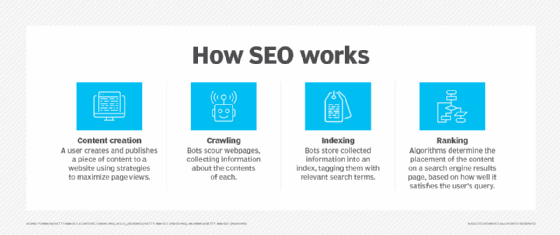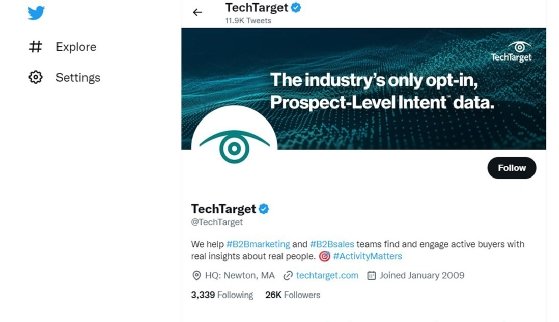meta description tag
What is a meta description?
A meta description tag is a snippet of Hypertext Markup Language (HTML) code in a web page header that summarizes the content that's on the web page. It's considered a best practice to use meta description tags when performing search engine optimization (SEO).
An effectively crafted meta description can convince readers that the web page they're going to access will provide the information they're looking for.
Examples of meta descriptions
The meta description is usually placed after the meta title tag and before the meta keywords tag in the header code. The following example shows how the meta description is typically placed inside the HTML tags.
<head>
<meta name="description" content="This is an example of a
meta description. This will often show up in search results.">
</head>
The following screenshot shows how a meta description will appear as part of a search engine results page (SERP) snippet.

Note that the meta description appears just below the web page's breadcrumb path, or the secondary navigation, and the clickable title tag.
How long should the meta description be?
Traditionally, the max characters viewed on the SERP have been 150-160. While the meta descriptions can be any length, Google truncates snippets to between 155 to 160 characters. Ideally, the meta descriptions must describe what's been talked about on the web page. For that, they must be sufficiently descriptive, which could be anywhere from 50 to 160 characters. Google's recent meta description length is up to 920 pixels, which is approximately 158 words. On mobile devices, this limit is about 680 pixels and 120 characters.
The optimal length varies from page to page. But the primary goal of adding a meta description is to provide value and drive clicks. Keep in mind that these recommended lengths might change over time, as Google is known for making changes to meta description length allowances without prior notice.
Do meta descriptions affect rankings?
Google announced in September 2009 that neither meta descriptions nor meta keywords factor into its ranking algorithms for search results. However, the meta description might appear on the SERP page if Google doesn't find a snippet on the page that contains the keyword the user is searching for.
While meta descriptions don't affect the search rankings of a website, they're an important aspect of SEO strategy, since they're the first encounter an internet reader has with a web page. They also affect another important metric known as the organic click-through rate (CTR), which is a percentage of the internet searchers who click on an organic SERP. A good meta description can help drive traffic to a website, thus improving its ranking.

Meta descriptions utilized on social media
Like meta description tags on web pages, social meta tags give website owners a bit of control over what content shows up when their web page is shared on social media platforms, such as Facebook, LinkedIn and Twitter.
Instead of the social media websites generating a headline description and image and deciding on how the content is displayed on their feeds, the website owner gets to do that. Social meta tags, also known as open graph meta tags, depend on the open graph protocol, which is a set of rules that enables any web page to become a rich object in a social graph. A website that uses open graph tags should have the proper functionality to be used on social media platforms.

Can Google rewrite the meta description?
According to a study conducted by web optimization company Zyppy, Google rewrites meta descriptions almost 61% of the time. There are several reasons why Google's algorithm thinks it can write better meta descriptions than website owners. According to Google's Search advocate John Mueller, the following scenarios might compel Google to rewrite the meta descriptions of web pages:
- Google views the meta description as being not descriptive or relevant to the page content.
- The same meta description can be found across multiple pages, which makes it not descriptive.
- The content on the page matches the searcher's intent, but the meta description doesn't.
- Modifiers are added to search queries, especially when the search query isn't included in the content.
- Titles are either too long or too short.
- The same keywords are used more than once.
- Title separators, such as dashes ("-") or pipes ("|") are used.
- Missing or superfluous brand names are used.
How to write a strong meta description
A meta description is a pitch for a web page and should address how the page can be useful to the reader. It should also accurately reflect what's included on the page.
The following are seven tips on how to write a good meta description:
- Keep it concise. When readers scan through the SERPs, they're looking for concise statements that answer their queries. This means a meta description must be divided into two to three short sentences rather than one long sentence. It should also be devoid of keyword stuffing and easily readable.
- Add a call-to-action (CTA). A meta description should always include a CTA that compels readers to click through to a page. A CTA helps the user experience and helps readers understand what's being offered and what to expect after clicking on the CTA. For example, CTAs for e-commerce websites might include words such as "shop now," "browsing the collection" or "discovering new trends."
- Keep it unique. A meta description must be high quality and unique as well as accurately convey what the web page offers. If website owners use an SEO plugin to generate automatic descriptions, they should ensure that the unique meta descriptions for each page aren't duplicated. Plugins and meta description generators might work for brands that have thousands of stock-keeping units and not enough staff to write them. But it's best for small businesses to write meta descriptions for their web pages manually to keep them unique.
- Address the topic. The meta description should address and summarize the topic of the landing page. This helps users know what to expect.
- Use the target keyword. Website owners should try to include the target keywords of the page in the meta description to help the search engines with page rankings. While adding a target keyword might not always be a ranking factor for Google, if it matches the search term, Google might automatically highlight the keyword in the snippet. This can bring more attention to the page.
- Be careful with special characters. Special, non-alphanumeric characters, such as hearts and symbols, can be inserted into a meta description. While they highlight the snippet, using these special characters excessively might seem untrustworthy and put off some readers.
- Keep the length optimal. Meta descriptions get truncated or cut off after the 155-character limit when displayed in search. Therefore, it's best to add the most important text and action phrases at the beginning of the description.
Besides meta descriptions, there are other ways for businesses to improve their rankings in search engines. Explore eight ways to boost a web page's ranking in the SERPs.
